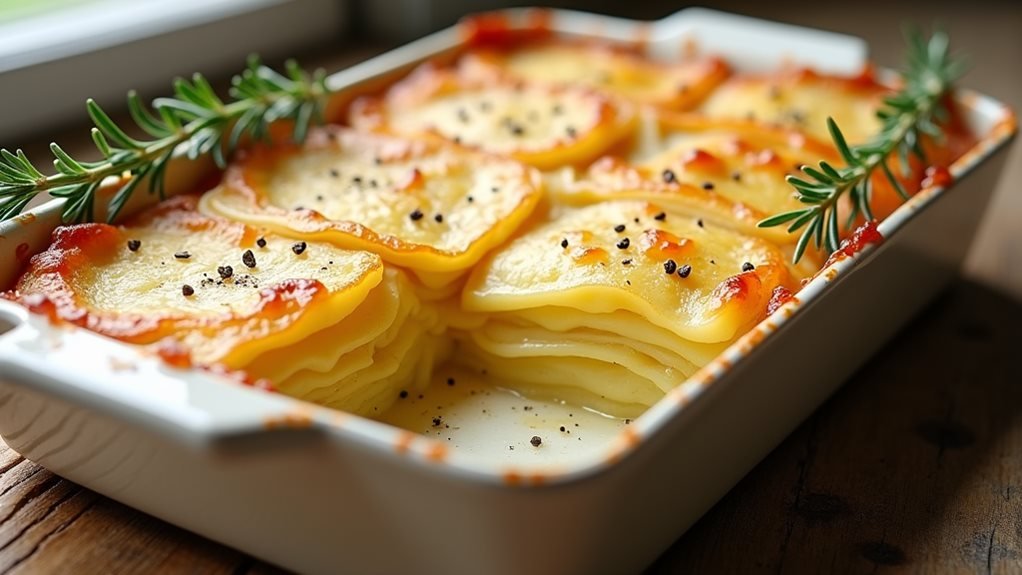Like the legendary King Midas, who turned everything he touched to gold, Gordon Ramsay’s influence has transformed the humble butterboard into a culinary masterpiece worthy of your Thanksgiving table. You’ll find that this modern interpretation of compound butter isn’t just another passing food trend – it’s a sophisticated elevation of a classic that’ll innovate how you serve bread at holiday gatherings. The secret lies in selecting premium ingredients and mastering Ramsay’s distinctive presentation techniques, which turn simple butter into an artistic centerpiece that’ll have your guests reaching for their phones before their bread.
Recipe Insights
- Combine European-style butter with fresh sage, rosemary, and thyme, creating swirled patterns reminiscent of Ramsay’s signature presentation style.
- Layer bold flavors with crushed garlic, cracked black pepper, and Maldon salt, finishing with a drizzle of local honey.
- Use a wooden board pre-chilled for 10 minutes, spreading butter evenly at 1/4-inch thickness for optimal serving temperature.
- Incorporate seasonal elements like toasted pecans, dried cranberries, and orange zest for a Thanksgiving-specific twist.
- Serve alongside warm, crusty sourdough and rustic baguette slices, arranging them in a circular pattern around the board.
History
Innovation in food presentation has always sparked culinary trends, and the butterboard phenomenon gained massive popularity in 2022 through social media platforms, particularly TikTok. This modern interpretation of compound butter service actually draws from centuries-old European traditions of serving flavored butter at formal gatherings.
The concept’s roots can be traced back to medieval European banquets, where butter was often presented with herbs and spices as a symbol of wealth. In the 17th and 18th centuries, French cuisine enhanced butter service to an art form, introducing elaborate presentations of herb-infused butter at royal courts. You’ll notice that today’s butter boards combine these classical techniques with contemporary styling.
The current revival emerged when food creator Justine Doiron popularized the concept on social media, drawing inspiration from chef Joshua McFadden’s original board ideas. Since then, you’ve likely seen countless variations emerge, from sweet to savory combinations. Much like the classic vinaigrette ratio of three parts oil to one part vinegar, these butter boards require careful attention to proportions and balance of flavors. This fusion of historical serving methods with modern presentation techniques has transformed a simple spread into an Instagram-worthy centerpiece that’s both practical and visually striking.
Recipe
A butter board is a modern twist on the traditional compound butter, offering an artistic and interactive way to serve seasoned butter at your gathering. This enhanced appetizer combines the richness of quality butter with fresh herbs, honey, and sea salt to create a visually stunning and delicious spread.
The success of a butterboard lies in its preparation and timing. The butter must be perfectly softened to achieve the ideal spreading consistency while maintaining its structure enough to hold decorative patterns. This recipe creates enough butterboard servings for 8-10 guests and can be customized with different herbs and toppings to suit your taste preferences.
- 2 cups unsalted butter
- 3 tablespoons fresh sage leaves
- 2 tablespoons fresh thyme leaves
- 2 tablespoons flaky sea salt
- 1 tablespoon honey
- 1 wooden or marble board
- Crusty bread for serving
Remove butter from the refrigerator and let it soften at room temperature for 30 minutes. Thoroughly clean and dry your wooden or marble board. Using the back of a spoon, spread the softened butter across the board in decorative swirls and waves, creating peaks and valleys.
Finely chop the sage and thyme, then sprinkle evenly over the butter surface. Drizzle honey in a crosshatch pattern across the top, then finish with an even sprinkle of flaky sea salt.
Similar to how creamy fricassée sauce transforms a simple chicken dish into an elegant meal, this butterboard elevates ordinary bread into a memorable appetizer.
For best results, prepare your butter board no more than 2 hours before serving. If your kitchen is particularly warm, refrigerate the board for 10 minutes before serving to maintain the butter’s texture. Avoid using plastic boards as they can retain odors and affect the taste.
When serving, provide several small spreading knives to maintain food safety. If the board will be sitting out for an extended period, consider placing it on a larger tray with ice packs underneath.
Cooking Steps
Start by preheating the oven to 350°F for the bread and letting the butter soften at room temperature for precisely 30 minutes.
You’ll want to finely chop your fresh herbs until they’re almost powder-like, then use the back of a spoon to spread your butter in elegant swirls across your chosen board.
Ultimately, drizzle honey in a crosshatch pattern over the butter and finish with a sprinkle of flaky sea salt, creating an impressive presentation that’s ready to serve.
Step 1. Preheat bread to 350F
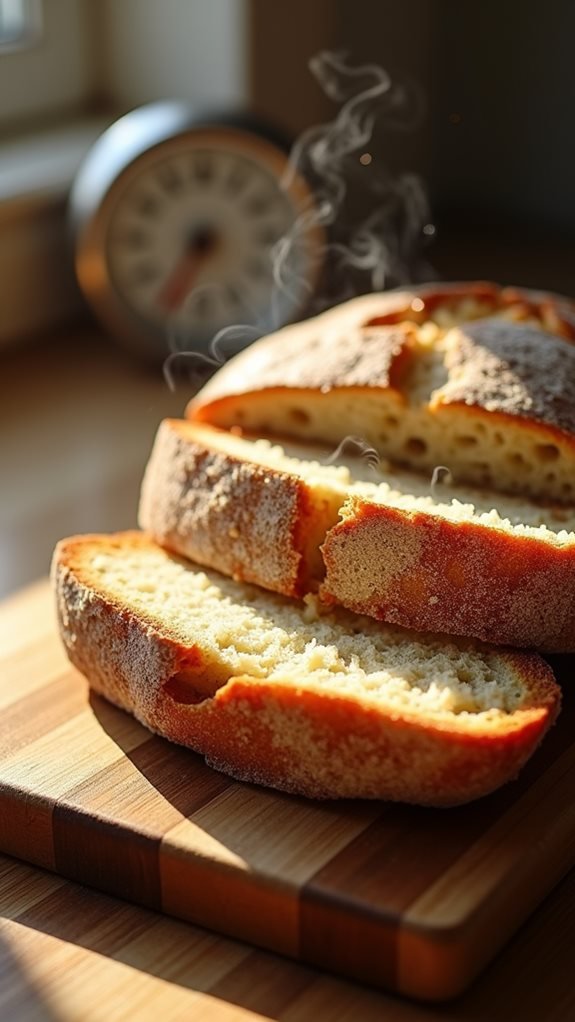
While your butter board rests at room temperature, preheat your oven to 350°F to warm the bread. You’ll want to guarantee that your bread selections complement the herbed butter’s flavors, so choose a variety of artisanal options like sourdough, crusty baguettes, or rustic country loaves.
Once your oven reaches temperature, slice your bread into portions that are easy for guests to handle, typically 1/2-inch thick pieces. Arrange them in a single layer on a baking sheet, being careful not to overcrowd.
You’ll need to warm the bread for 5-7 minutes, just until it’s heated through and slightly crispy on the outside while maintaining a soft interior. If you’re working with multiple bread varieties, you might need to adjust the timing slightly for each type.
For the best serving experience, warm your bread in batches throughout your gathering rather than all at once. This guarantees each guest experiences the perfect combination of warm bread and room-temperature compound butter, creating a satisfying contrast of temperatures that enhances the entire experience.
Step 2. Soften Butter at Room Temp
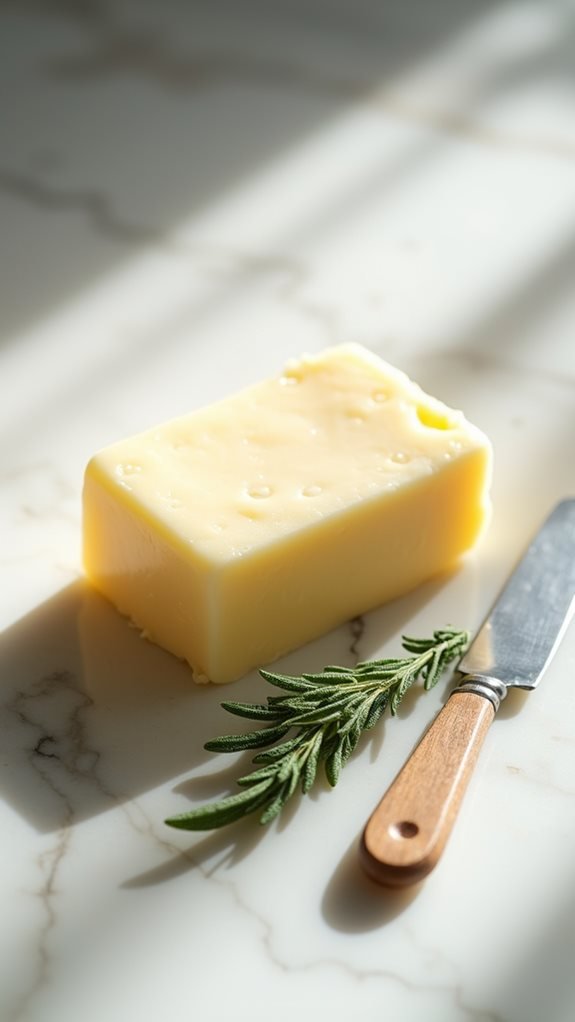
Properly softened butter is the foundation for a successful butter board, requiring precise timing and temperature control. Remove your butter from the refrigerator and let it rest at room temperature for exactly 30 minutes. The ideal consistency should allow your finger to leave a slight indentation without sinking in completely.
For best outcomes, cut your cold butter into 1-inch cubes before setting it out to soften. This guarantees even temperature distribution throughout the entire block. Your kitchen’s ambient temperature should be between 65-70°F for the most favorable results. If your kitchen runs warmer, you’ll need to adjust the softening time accordingly.
You can test the butter’s readiness by gently pressing it with a spatula – it should spread smoothly without becoming greasy or melted.
Don’t rush this process by using the microwave or other heating methods, as they’ll create inconsistent temperatures that will affect your final presentation. If you’ve softened the butter too much, return it to the refrigerator for 5-10 minutes until it reaches the proper spreading consistency.
Step 3. Chop Herbs Until Fine

Fresh herbs demand careful preparation to release their full aromatic potential in your butter board. Gather your sage leaves into a tight cluster, then use a sharp chef’s knife to slice through them with precise, controlled motions. Continue chopping until the pieces are uniformly fine, about the size of small confetti.
For the thyme, you’ll need to initially strip the tiny leaves from their woody stems by holding the top of each sprig and pulling backward against the stem’s growth direction. Once you’ve gathered the leaves, chop them using the same technique as the sage. Don’t rush this process – proper herb preparation is vital for achieving an even distribution of flavors throughout your butter board.
Remember to wipe your cutting board clean between herbs to prevent premature mixing of their necessary oils. You’re aiming for distinct, individual flavors that will complement each other once they’re arranged in your final presentation.
If you notice any tough stems or discolored leaves during chopping, remove them immediately to maintain the highest quality in your finished dish.
Step 4. Spread Butter in Swirls
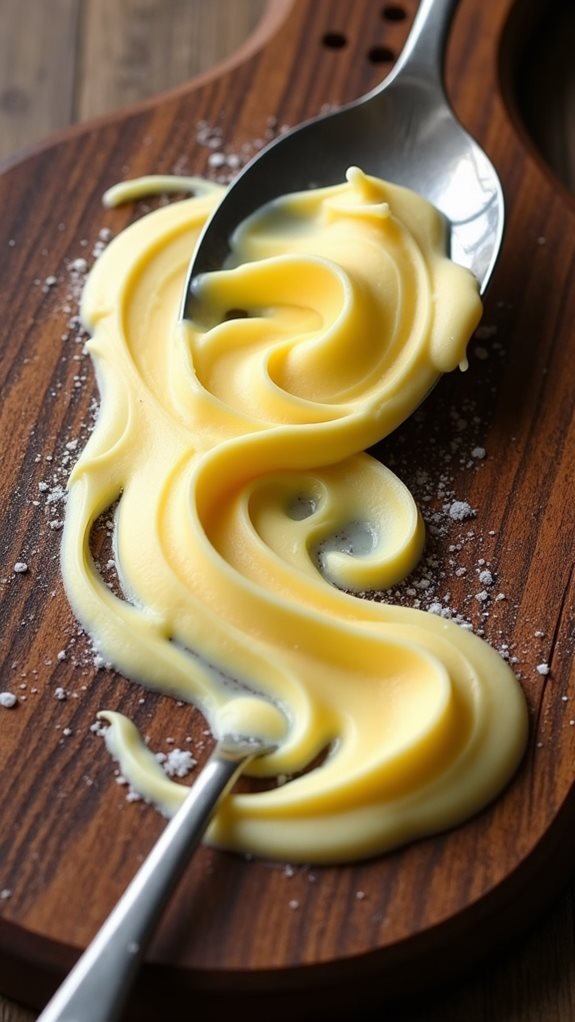
Creating beautiful swirls starts with your perfectly softened butter and a clean board as your canvas. Using the back of a spoon, begin at the center of your board and work outward, applying gentle pressure to create flowing wavelike patterns. You’ll want to maintain an even thickness of about 1/4 inch throughout your design.
As you spread, focus on developing organic, free-flowing movements that will give your butter board a natural, artistic appearance. Don’t worry about achieving perfect symmetry; instead, concentrate on creating valleys and peaks that will catch your herbs and honey. If you notice the butter becoming too soft, pause and refrigerate your board for five minutes before continuing.
Work quickly but deliberately, ensuring complete coverage across your chosen surface area. You can use the edge of your spoon to create deliberate ridges or the flat back to smooth certain areas for contrast. Remember to leave about an inch of space around the board’s perimeter to prevent any overflow when you’re adding your toppings.
If you make a mistake, smooth it out and start that section again.
Step 5. Add Honey Salt Garnish
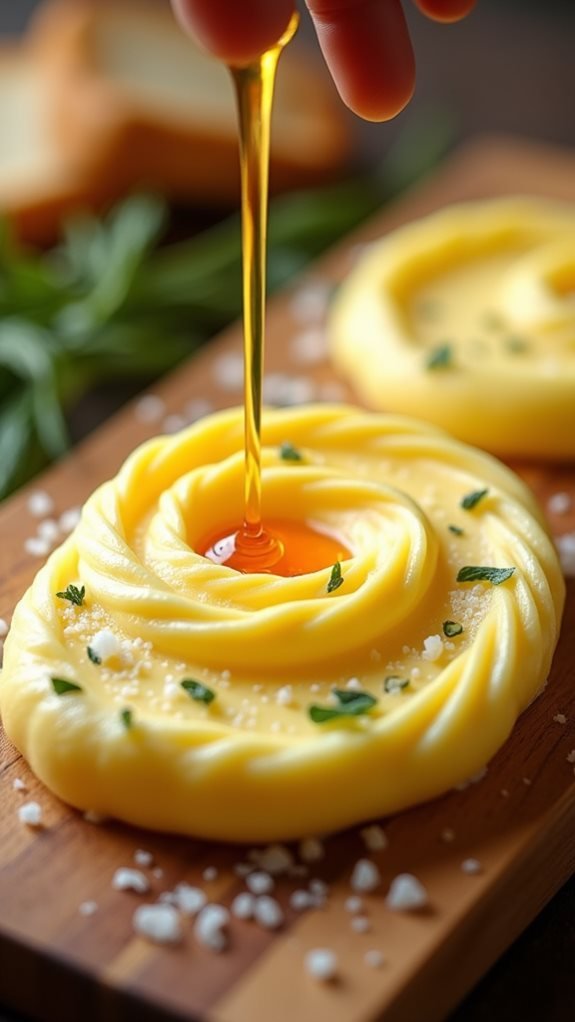
The final decorating step transforms your butterboard from beautiful to extraordinary. Using a gentle touch, drizzle honey in an intentional crosshatch pattern across the butter’s swirled surface, creating delicate lines that’ll catch the light and add visual depth. Don’t rush this process; precision matters for both aesthetics and taste distribution.
Next, you’ll want to sprinkle flaky sea salt with purpose, ensuring uniform coverage across the entire board. Hold your hand about 12 inches above the surface and let the salt crystals fall naturally, which helps achieve consistent distribution. You’re aiming for a light dusting that’ll provide bursts of flavor without overwhelming the herbs and honey.
If you’re serving immediately, leave the board at room temperature. However, if you’ve prepared this ahead of time, refrigerate for exactly 10 minutes before guests arrive. This timing guarantees the butter maintains its spreadable consistency while remaining firm enough to hold its artistic pattern. Remember to place small spreading knives at different points around the board, allowing your guests to serve themselves without disturbing the entire presentation.
Common Questions About This Recipe
Many home cooks have questions about making butter boards, especially when preparing them for the first time. Butter temperature is pivotal—if it’s too soft, you’ll lose definition in your swirls, and if it’s too firm, you won’t achieve the desired spreading consistency. When guests ask about food safety, assure them that a two-hour serving window at room temperature is perfectly safe for butter.
If you’re wondering about make-ahead options, you can prepare the compound butter mixture up to three days in advance, but don’t spread it on the board until serving a day.
For those concerned about dairy alternatives, you can substitute plant-based butter, though the texture will be less indulgent.
When selecting a board, wooden or marble surfaces work best, as they maintain temperature effectively and won’t affect the butter’s flavor.
If you’re serving a large group, plan for about 2 tablespoons of butter per person. Remember, you can scale the recipe up or down while maintaining the same ratio of herbs and seasonings.
Final Thoughts and Serving Ideas
Successful butterboards rely heavily on thoughtful presentation and strategic serving arrangements. You’ll want to position your board in an easily accessible spot where guests can gather comfortably, ideally on a stable surface away from direct heat sources.
Consider placing small serving knives at multiple points around the board to prevent bottlenecks and maintain the board’s aesthetic appeal throughout service.
To enhance your butter board’s impact, you’ll need to think about timing and temperature control. While you can prepare the board up to two hours before guests arrive, you’ll achieve the best results by bringing it out 15-20 minutes before serving.
Pair your creation with an assortment of breads – warm sourdough, crusty baguettes, and artisanal rolls work exceptionally well. You might also consider setting out small plates nearby to catch any crumbs and provide guests with a comfortable eating experience.
If you’re serving outdoors or in warm conditions, it’s wise to have a backup board chilling in the refrigerator, ready to swap out when needed. Remember to monitor the consistency of your butter throughout service, adjusting its placement as necessary to maintain the perfect spreading texture.





